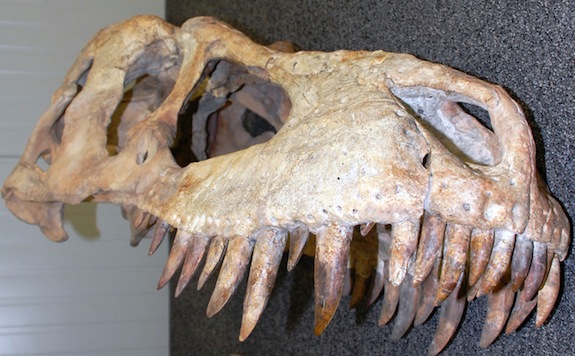U.S. Gives Mongolia Its Tyrannosauras Skeleton Back
The U.S. government is returning a Tyrannosaurus skeleton to Mongolia and the Metropolitan Museum of Art is giving two statues back to Cambodia
The U.S. government has decided to return looted national treasures to their respective countries. Mongolia will get a 70-million-year-old Tyrannosaurus bataar (a slightly smaller cousin to T. rex) skeleton back, and Cambodia will receive two life-sized 10th century Khmer statues called the Kneeling Attendants.
The reconstructed skeleton, which is 8 feet tall and 24 feet long, was unearthed in the Gobi desert in 1946 by a Soviet and Mongolian team, Reuters reports. In 2010, the skeleton arrived in the U.S. from the U.K. along with a customs document that falsely stated that the fossils originated in Britain and that they were only worth $15,000.
Mongolia demanded that the U.S. return the T. bataar skeleton after it was auctioned for $1.05 million last spring by Floridian Eric Prokopi. Here’s how the auction house described the item:
This is an incredible, complete skeleton, painstakingly excavated and prepared, and mounted in a dramatic, forward-leaning running pose. The quality of preservation is superb, with wonderful bone texture and delightfully mottled grayish bone color. In striking contrast are those deadly teeth, long and frightfully robust, in a warm woody brown color, the fearsome, bristling mouth and monstrous jaws leaving one in no doubt as to how the creature came to rule its food chain. Equally deadly and impressive are the large curving claws, with pronounced blood grooves. The body is 75% complete and the skull 80%…
Because of the kerfuffle, the sale was eventually canceled. Charges have since been filed against Prokopi, and the skeleton was returned to Mongolia on Monday. An official from the U.S. Immigration and Customers Enforcement told Reuters that this “is one of the most important repatriations of fossils in recent years.”
Cambodia, likewise, will soon be reunited with its missing relics. The Metropolitan Museum of Art in New York City received the two sandstone statues, which came as separate broken heads and torsos, as gifts in 1987 and 1992, Archaeology reports. But over the years, evidence mounted that the statues had been looted from Cambodia’s Koh Ker temple during the tumultuous Cambodian Civil War in the 1970s. Witnesses, Archeology writes, can remember seeing the statues in the temple up until 1970 but that they were gone by 1975.
According to the New York Times, the museum assured Cambodia in a letter last month that the statues will be returned as soon as appropriate transit arrangements can be sorted out, though no timeline has been set.
The Met’s decision reflects the growing sensitivity by American museums to claims by foreign countries for the return of their cultural artifacts. Many items that have long been displayed in museums do not have precise paperwork showing how the pieces left their countries of origin. In recent years, at the urging of the Association of Art Museum Directors and scholars, many museums have applied more rigorous standards to their acquisitions.
Cambodian officials have asked the Met to examine another two dozen artifacts that may have been looted, and, according to Reuters, the U.S. is also helping to return additional fossils to Mongolia.
More from Smithsonian.com:
Looters Destroy Dinosaur Nest Sites
Looters Are Selling Artifacts to Fund War in Syria
/https://tf-cmsv2-smithsonianmag-media.s3.amazonaws.com/accounts/headshot/Rachel-Nuwer-240.jpg)

/https://tf-cmsv2-smithsonianmag-media.s3.amazonaws.com/accounts/headshot/Rachel-Nuwer-240.jpg)